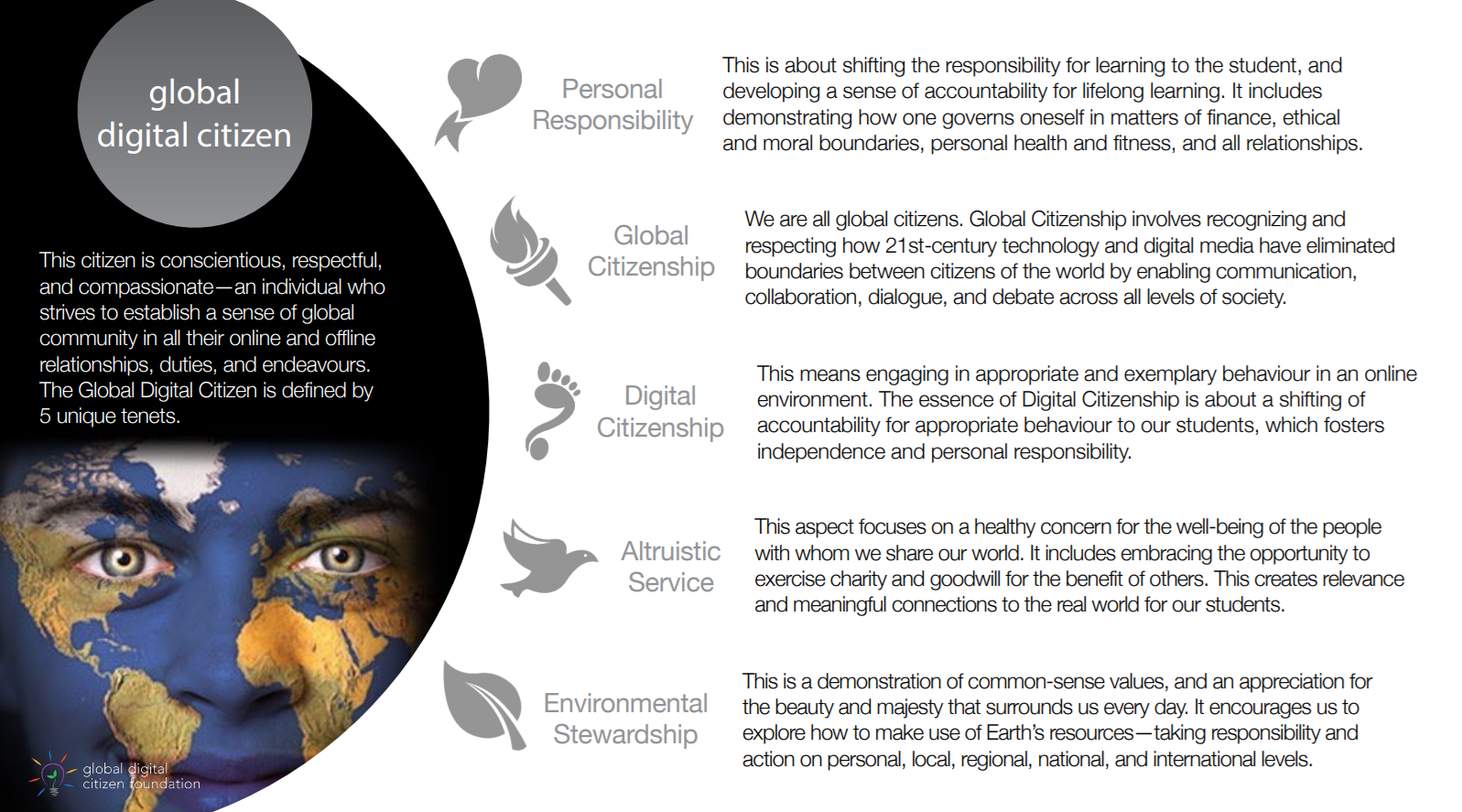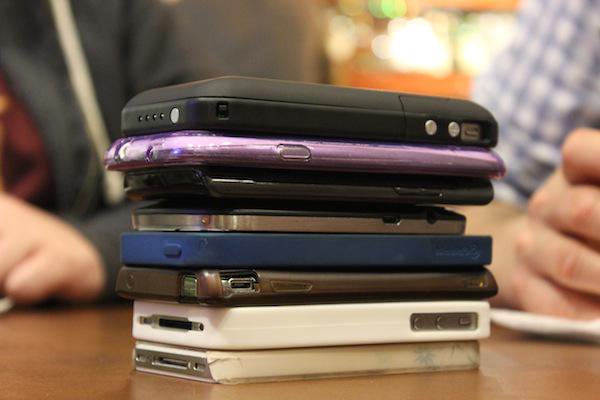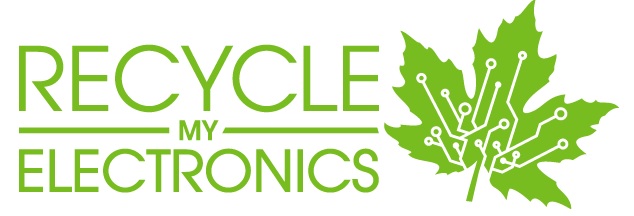Digital Citizenship: From Design to Recycling

*This post has been written as part of my journey through my Master’s Degree in Curriculum & Planning through Brandon University
This week our Internet for Teachers (#BU755) class delved into the question of:
What does Digital Citizenship look like in a global political context?
 |
| Global Digital Citizen Quickstart Skills Guide. (Accessed 2017). Uploaded by the Global Digital Citizen Foundation. Available online at: https://globaldigitalcitizen.org/ |
When it comes to the concept of digital citizenship a quick Google search brings up numerous items involving skills around netiquette, digital footprint, collaboration, or any number of other individual skills designed to teach the, “norms of appropriate, responsible online use” (Ribble, 2017). Admittedly, the majority of the conversations I have had surrounding digital citizenship have been primarily focused on these types of skills as well. While I strongly believe that these skills are arguably essential for anyone using web 2.0 technologies, our readings this week pushed past these seemingly surface-level aspects and forced us to reflect on the global political context surrounding digital technology.
What is global citizenship in a digital world?
(Redekopp, 2016).
Reynold Redekopp (2016, p. 126-127) argues that in order to approach digital citizenship within a global political context students need to engage in the following areas:
1. Design
– Why do we go through SO many devices so quickly?
– Who else has a drawer full of device designs that they no longer use?
– A quick walk around our house unearthed old Samsung flip phones, a Motorola Razr phone, multiple iPod version,
2 iPhone 4s (not to mention everything from an original NES and Playstation, to multiple Wii and X-Box models)
– Many devices are designed to be difficult or nearly impossible to upgrade
– Companies naturally want you to buy new when something goes wrong or a “better” model is available
– Batteries that lose their charge, screens that crack easily, new/”better” models released regularly
– I remember seeing the Phoneblocs concept pop up on my Facebook feed as part of a fundraising campaign and thought that it was such a simple yet ingenious idea! This could solve many design issues. Why aren’t more products designed using this type of model?
Phoneblocs. (2013). Uploaded to YouTube by Dakehakkens. Available online at: https://www.youtube.com/watch?v=oDAw7vW7H0c
2. Mineral Sourcing
– What minerals are needed to create the devices you use?
– Where and how are the minerals extracted?
– What conflicts surround these resources and how long are they sustainable?
 |
| Cell Phones are the new blood diamonds. (2016). Uploaded to Return to Now. Available online at: http://returntonow.net/2016/09/25/cell-phones-are-the-new-blood-diamonds/ |
Conflict Minerals 101. (2009). Uploaded to YouTube by Enough Now. Available online at: https://www.youtube.com/watch?v=aF-sJgcoY20
3. Manufacturing
– Where is your device made?
– What conditions do those employees work under?
– Do you want to support this company or take action?
– Consumers do have a voice and their actions can force companies to make the appropriate changes
– Students should realize that they do have the power to make big changes for others in the world
Apple accused of failing to protect workers. (2014). Uploaded to YouTube by BBC News. Available online at: https://www.youtube.com/watch?v=kSvT02q4h40
4. Consumption
– How often do you NEED a new device?
– Is the NEED related to a design-flaw like what was discussed in point 1 or is it a WANT?
– While I admit that I cycled through phones A LOT as a late teen and in my early 20s because I wanted the new and upgraded model
– I did however, hold onto my iPhone 4 for about 4 years (almost unheard of in the Apple world!) before the battery wouldn’t last an hour and I upgraded (design flaw)
– Those multiple video game devices though? Purely want; not need
– What is responsible consumption and what factors influence it?
– Is the NEED related to a design-flaw like what was discussed in point 1 or is it a WANT?
– While I admit that I cycled through phones A LOT as a late teen and in my early 20s because I wanted the new and upgraded model
– I did however, hold onto my iPhone 4 for about 4 years (almost unheard of in the Apple world!) before the battery wouldn’t last an hour and I upgraded (design flaw)
– Those multiple video game devices though? Purely want; not need
– What is responsible consumption and what factors influence it?
 |
| Good idea. (2015). Uploaded to Twitter by Terry Small. Available online at: https://twitter.com/terrysmall/status/597834214650695680 |
5. Energy
– When most student think of energy and technology they think of how long their battery is going to last through the day
– Where is the nearest charger?!?
– But how much energy does it take to complete the tasks technology can accomplish?
– How much energy does a Google search take?
– Think of how much some devices heat up while you use them
– Is the energy involved in the mineral extraction, manufacturing, and consumption a CLEAN energy?
– Where is the nearest charger?!?
– But how much energy does it take to complete the tasks technology can accomplish?
– How much energy does a Google search take?
– Think of how much some devices heat up while you use them
– Is the energy involved in the mineral extraction, manufacturing, and consumption a CLEAN energy?
How much energy does the internet use? (2015). Uploaded to YouTube by SciShow. Available online at: https://www.youtube.com/watch?v=iuZDylVFbhs
6. Recycling
– How do we go about recycling our unwanted technology?
– People are getting better about appropriately recycling items like batteries, but what about the rest of the device?
– Where is the nearest drop-off location?
– In Manitoba you can find more information by checking out Recycle my Electronics
– People are getting better about appropriately recycling items like batteries, but what about the rest of the device?
– Where is the nearest drop-off location?
– In Manitoba you can find more information by checking out Recycle my Electronics
 |
| Recycle my Electronics. (2017). Uploaded by CPRA. Available online at: https://www.recyclemyelectronics.ca/mb |
7. Cost
– How much would you be willing to pay to fix these problems?
– Would you donate to organizations fighting for conflict free mineral extraction and fair manufacturing conditions?
– How much does your consumption cost you?
– How much does it cost to switch over to greener energies?
– Are these costs realistic for you?
How would you go about discussing these aspects of digital citizenship with your students? As a social studies teacher I naturally think of the multiple outcomes these areas could fall into at different grade levels. Would you incorporate it into a pre-existing curriculum? Mention it as topics arise? (ex. a new piece of technology is installed in the classroom). Integrate it with other digital citizenship topics? Share your thoughts in the comment section below!
Weekly Reading References:
Redekopp, R. (2016). Digital Citizenship Reconsidered: Global Citizenship In A Digital World. In Nantais, M., & Reddekopp, R. (Eds.) Education and technology: Manitoba action and reaction. Retrieved from http://www.manace.ca/hot-off-the-press/
Emejulu, A., & McGregor, C. (2016): Towards a radical digital citizenship in digital education, Critical Studies in Education, DOI: 10.1080/17508487.2016.1234494
– Would you donate to organizations fighting for conflict free mineral extraction and fair manufacturing conditions?
– How much does your consumption cost you?
– How much does it cost to switch over to greener energies?
– Are these costs realistic for you?
How would you go about discussing these aspects of digital citizenship with your students? As a social studies teacher I naturally think of the multiple outcomes these areas could fall into at different grade levels. Would you incorporate it into a pre-existing curriculum? Mention it as topics arise? (ex. a new piece of technology is installed in the classroom). Integrate it with other digital citizenship topics? Share your thoughts in the comment section below!
Weekly Reading References:
Redekopp, R. (2016). Digital Citizenship Reconsidered: Global Citizenship In A Digital World. In Nantais, M., & Reddekopp, R. (Eds.) Education and technology: Manitoba action and reaction. Retrieved from http://www.manace.ca/hot-off-the-press/
Emejulu, A., & McGregor, C. (2016): Towards a radical digital citizenship in digital education, Critical Studies in Education, DOI: 10.1080/17508487.2016.1234494
Hi Kirsten,
I enjoyed reading your post as it is the next step in my thoughts regarding a need to better educate everyone on what it means to be a good digital citizen. My post was a reflection on the difference between cybersafety and digital citizenship, which is where I think many of us get stuck in our teaching. I really like the questions you posed, as I could easily see them both as essential questions of their own, or as components of other curriculum, specifically the grade 10 Geography. A teacher could easily connect the consumer choice questions into clusters 2, 4, and 5.
I also really like the phonebloks idea!
So a few things – I want phone that I can assemble like lego. Amazing.
There are so many different ways to connect all of your questions to different MB curriculum – there really isn't an area where someone could say it doesn't fit! Students, at least as they get older, are so focused on their devices, I could see middle and high school students really digging deep into these topics! I took some of the ideas and resources from the Emejulu article to one of the PLC groups in my building and now they are creating a mini-unit together based on it. I'm definitly going to share your post with them! Thanks 🙂
Hi Chelsea, this is very neat – I hope you can share what your PLC comes up with when it is done! So very cool that these articles and posts are stirring such action!
Hi, I really enjoyed how you presented your information and including supporting videos to share it. I see many opportunities for teachers to share this information with students and also using inquiry to delve deeper. It also reminds me of the Blood diamond information that was around in the 90's. At that time consumers were advised where their diamonds came from and how they were acquired which had a positive spin on Canada's diamond industry. You will note that Canadian diamonds have the Canadamark engraved on them which allows you to track where is was mined and cut. Essentially ensuring it is a conflict-free diamond.